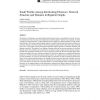Free Online Productivity Tools
i2Speak
i2Symbol
i2OCR
iTex2Img
iWeb2Print
iWeb2Shot
i2Type
iPdf2Split
iPdf2Merge
i2Bopomofo
i2Arabic
i2Style
i2Image
i2PDF
iLatex2Rtf
Sci2ools
114
Voted
CMOT
2004
2004
Small Worlds Among Interlocking Directors: Network Structure and Distance in Bipartite Graphs
We describe a methodology to examine bipartite relational data structures as exemplified in networks of corporate interlocking. These structures can be represented as bipartite graphs of directors and companies, but direct comparison of empirical datasets is often problematic because graphs have different numbers of nodes and different densities. We compare empirical bipartite graphs to simulated random graph distributions conditional on constraints implicit in the observed datasets. We examine bipartite graphs directly, rather than simply converting them to two 1-mode graphs, allowing investigation of bipartite statistics important to connection redundancy and bipartite connectivity. We introduce a new bipartite clustering coefficient that measures tendencies for localized bipartite cycles. This coefficient can be interpreted as an indicator of inter-company and inter-director closeness; but high levels of bipartite clustering have a cost for long range connectivity. We also investig...
| Added | 16 Dec 2010 |
| Updated | 16 Dec 2010 |
| Type | Journal |
| Year | 2004 |
| Where | CMOT |
| Authors | Garry Robins, Malcolm Alexander |
Comments (0)

